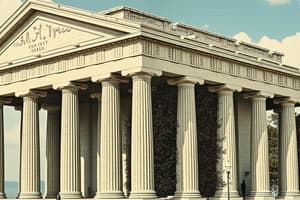Podcast
Questions and Answers
What is an architectural order?
What is an architectural order?
- An assemblage of parts subject to uniform established proportions (correct)
- A style of painting
- A method of construction
- A type of building material
Name the five orders in classical Greek and Roman architecture.
Name the five orders in classical Greek and Roman architecture.
Ionic, Doric, Corinthian, Composite, Tuscana
Which order is characterized by volutes on their capitals?
Which order is characterized by volutes on their capitals?
- Corinthian Order
- Doric Order
- Ionic Order (correct)
- Composite Order
What is the function of a column's capital?
What is the function of a column's capital?
What does the entablature typically consist of?
What does the entablature typically consist of?
What is the primary function of a cornice?
What is the primary function of a cornice?
What are metopes?
What are metopes?
Match the following terms with their definitions:
Match the following terms with their definitions:
What is travertine?
What is travertine?
When did arches first appear in architecture?
When did arches first appear in architecture?
Flashcards are hidden until you start studying
Study Notes
Architectural Orders
- Architectural orders are systems of design in ancient Greek and Roman architecture characterized by specific proportions and styles.
- The five classical orders include Ionic, Doric, Corinthian, Composite, and Tuscana.
Ionic Order
- An architectural style from ancient Ionia, prevalent during the Greek Archaic Period (750-480 BCE).
- Notable for its slender columns topped with volutes.
Capital
- The capital is the topmost part of a column, serving as a transition between the column and the weight above.
- It increases the surface area for better weight distribution.
Entablature
- Comprises horizontal moldings above columns, divided into architrave, frieze, and cornice.
- The architrave is directly above the columns; the frieze may be plain or decorated; the cornice projects below the pediment.
Cornice
- A horizontal decorative molding crowning a building or architectural feature, such as door frames.
- Functions to direct rainwater away from the building's walls.
Frieze
- The central section of the entablature, which may feature either plain surfaces or detailed bas relief sculptures.
Metopes
- Rectangular elements in a Doric frieze between triglyphs, often adorned with paintings or sculptures.
- Famous examples include the Parthenon marbles, depicting mythological battles.
Architrave
- A beam resting on the capitals of columns, functioning similarly to a lintel in post-and-lintel construction.
Lintel
- A structural element that bears loads over openings like doors and windows, often decorative in nature.
Relief
- A sculptural technique where the material appears raised against a flat background.
- Created by chiseling away the background surface, leaving the raised figures standing out.
Triglyph
- The three-channel design in a Doric frieze, with two full and one divided channel per tablet.
- Metopes reside in the spaces between triglyphs.
Travertine
- A sedimentary rock formed from mineral-rich springs, particularly prevalent in hot springs.
Pediment
- A triangular gable placed above the entablature, commonly seen in classical architecture.
- Often embellished with relief sculptures illustrating scenes from mythology.
Arch
- Curved structures that span openings, potentially supporting loads above.
- First utilized systematically by Romans, though their origins date back to the 2nd millennium BCE in Mesopotamia.
Vault
- An architectural construct formed by extending an arch to create a ceiling or roof.
- Vaults are distinguished from arches by their continuous structure, providing significant support.
Studying That Suits You
Use AI to generate personalized quizzes and flashcards to suit your learning preferences.




